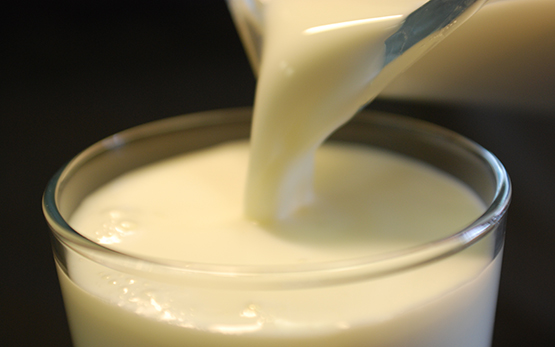
Buttermaking cream
The bulk of buttermaking cream is produced during cheesemaking. Here, a distinction is drawn between cream from milk and whey cream.
Some of the cheesemaking milk is centrifuged. The cream obtained from this is either churned into butter in the cheese dairy, or sold to a larger butter manufacturer. In addition, part of the fat is centrifuged out from a large proportion of the commercial milk in order to adjust fat content. Cream is also extracted during the production of skim-milk powder and the extraction of milk proteins from milk.
The whey produced during the cheesemaking process is also centrifuged. It still contains 2-3 g fat per litre. Whey cream produced by traditional cheesemaking in a copper vat has a high copper content. Because copper is a catalyst for fat oxidation, whey cream from traditional cheesemaking is prone to oxidation, and is processed separately into butter with a shorter shelf-life.
Pasteurisation
While the buttermaking cream is pasteurised, its temperature ranges from 63 °C for 30 min to 110 °C for 3-5 s, depending on the intended use and quality of the original cream. High pasteurisation temperatures promote oxidative stability and neutralise microbial lipases. These advantages, however, are offset by drawbacks such as a ‘cooked’ taste and increased risk of reinfection.
Cream-Ripening Processes
After pasteurisation, the cream is often subjected to a graduated heat treatment, the object being intraglobular fractionation of the milkfat. Optimum success in separating the solid and liquid fat fractions by so-called cold-warm-cold ripening results in a reduction in butter hardness. This is referred to as a physical cream-ripening. The still-liquid milkfat acts as a sliding phase.
This cream-ripening process can take the following form:
Cream is cooled to 4-8 °C after pasteurisation and several hours' storage
- Heating to 18-22°C (depending on fat hardness) for at least 2-4 hours
- Gradual cooling (formation of large disc-shaped crystals) to 6-8°C and storage (cooling may also be carried out in two stages)
- The cream is brought to churning temperature (10-13°C) before being made into butter.
To produce a not-too-soft butter in summer, the cream is warm-cold ripened to yield a harder product produced by stronger crystal cross-linking. Since consumers prefer butter that spreads easily straight from the fridge, this variant of cream ripening is not used very frequently (and presumably not at all in Switzerland).
Procedure: After pasteurisation, the cream is cooled to 20-22 °C and stored for several hours. Cooling occurs in two stages, initially to 14-16 °C, then after several hours to below 10°C. In both cases, cooling should be carried out quickly in order to obtain intensive crystal cross-linking.
In addition to undergoing a physical ripening, the cream for cultured-cream butter is also ripened bacteriologically with the aid of a so-called ‘starter’. The aims of this measure are twofold:
- To obtain a flavourful butter
- To increase protection from recontamination, and hence the shelf-life of the butter, by means of a low pH value
The starter culture contains the mesophilic lactic-acid bacteria Lactococcus lactis subsp. lactis, Lactococcus lactis subsp. cremoris, Lactococcus lactis subsp. diacetylactis, and in some cases Leuconostoc mensenteroides subsp. cremoris, which form lactic acid as well as flavouring compounds, in particular diacetyl. Ripening occurs at 18-21°C, and usually lasts for over 10 hours. In this phase, the cream must only be stirred slowly and gently. Only once casein precipitation starts (from approx. pH 4.8) can the now-creamy cream be intensively stirred, pumped and cooled. Premature stirring leads to a high fat content in the buttermilk. In cultured-cream butter production, physical ripening must be combined with flavour maturation.





